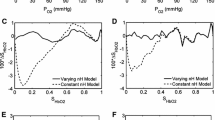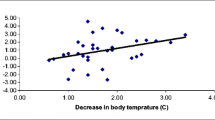Abstract
In a previous paper, published in this journal, we showed that the data obtained in patients with severe ketoacidosis suggest that inorganic phosphates (K2HPO4) can increase their P 50 and therefore enhance tissue oxygenation without concomitant alteration of the 2,3 diphosphoglycerate (DPG) [1]. In order to test the hypothesis that K2HPO4 could influence the oxyhemoglobin dissociation curve (ODC) by a mecanism which was not DPG mediated we have measured the total ODC on whole blood with and without addition of 13–80 mmol/1 of inorganic phosphates. On average, the level of DPG remained unchanged when the P 50 with K2HPO4 was significantly higher (p>0.001) (P 50=29.9±3.7 mmHg) than when phosphates were not administered (P 50=25.5±2.8 mmHg). The relationship between P 50 (mmHg) and K2HPO4 (=X mmol/1) was ΔP 50=−2.97 10−3(X)2+0.26(X)−0.42 (r=0.78).
Seeing that phosphates have an immediate action on the ODC, we calculated in our ketoacidosis patients, the relationship between the P 50, the inorganic phosphates (Pi in mg%) and the DPG in μmol/gHb. Both factors exert a highly significant effect (p<0.001) on the P 50, according to the following equation: P 50=0.35 DPG+0.26 Pi+18.92 (r=0.73). Our data are important in two points. First it is useful to add inorganic phosphates to the treatment of patients with severe ketoacidosis in order to enhance their tissue oxygenation. Second they recall that the ODC is not only determined by the classical effects of temperature, pH and DPG byt also by inorganic anions, like phosphates as described by Benesh and Benesh in their pioneering work [2].
Similar content being viewed by others
References
Clerbaux T, Reynaert M, Willems E, Frans A (1989) Effect of phosphate on oxygen hemoglobin affinity, diphosphoglycerate and blood gases during recovery from diabetic ketoacidosis. Intensive Care Med 15:495–498
Benesch R, Benesch RE (1970) Intracellular organic phosphates as regulators of oxygen release by hemoglobin. Nature 221:618–622
Ditzel J (1973) Effect of plasma inorganic phosphate on tissue oxygenation during recovery from diabetic ketoacidosis. In: Bisher HI, Bruley DF (eds) Oxygen transport to tissue: advances in experimental medicine and biology, vol 37 A. Plenum Press, NY, pp 163–172
Farhi LE (1965) Continuous duty tonometer system. J Appl Physiol 20:1098–1101
Clerbaux T, Fesler R, Bourgeois J (1973) A dynamic method for continuous recording of the whole blood oxyhemoglobin dissociation curve at constant temperature, pH and pCO2. Med Lab Technol 301–9
Fesler R, Clerbaux T, Brasseur L (1979) A microcomputerized oxyhemoglobin dissociation curve analyzer for clinical use. Computer Cardiol IEEE 379–382
Sottiaux B, Clerbaux T, Fesler R, Brohet C (1976) Computer processing of oxygen dissociation curve. Comput Prog Biomed 6:128–135
Amiconi G, Antonini E, Brunori M, Wyman J, Zolla L (1981) Interaction of hemoglobin with salts: effects on the functional properties of human hemoglobin. J Molec Biol 152:111–129
Antonini E, Amiconi G, Brunoni M (1971) The effect of anions and cations on the oxygen equilibrium of human hemoglobin. In: Rorth M, Astrup P (eds) Oxygen affinity of hemoglobin and red cell base status. Alfted Benzon Symposium IV, Munksgaard, Copenhagen, p 121–129
Rossi-Fanelli A, Antonini E, Caputo A (1961) Studies on the relations between molecular and functional properties of hemoglobin II. The effects of salts on the oxygen equilibrium of human hemoglobin. J Biol Chem 236:397–400
Zwart A, Kwant G, Oeseburg B, Zylstra WG (1982) Oxygen dissociation curves for whole blood, recorded with an instrument that continuously measured PO2 and SO2 independently at constant T, pCO2 and pH. Clin Chem 28:1287–1292
Cotes JE (1979) Lung function Assessment and application in medicine, 4th edn. Blackwell, Oxford, pp 605
Author information
Authors and Affiliations
Additional information
This work was supported by a grant of the Fonds de la Recherche Scientifique Médicale, no 3450.29.90
Rights and permissions
About this article
Cite this article
Clerbaux, T., Detry, B., Reynaert, M. et al. Reestimation of the effects of inorganic phosphates on the equilibrium between oxygen and hemoglobin. Intensive Care Med 18, 222–225 (1992). https://doi.org/10.1007/BF01709836
Received:
Accepted:
Issue Date:
DOI: https://doi.org/10.1007/BF01709836




